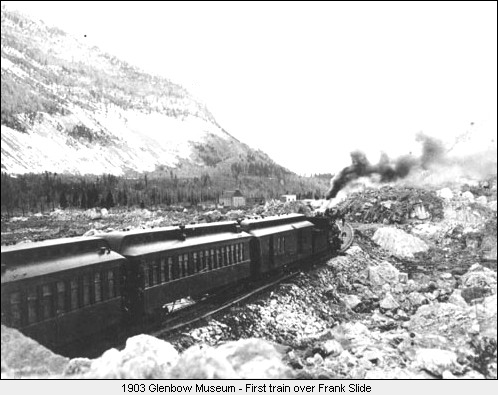
9 April 2008
Another Slide at Turtle Mountain is Inevitable

Frank Alberta - There was no warning more than a century
ago when 82 million tonnes of limestone crashed down from the peak of Turtle Mountain in the middle of the night burying a portion of
the sleeping town of Frank.
The massive rock slide in 1903 killed 70 people and it's inevitable that one day there will be another.
"It will happen, it's just a matter of when," said Corey Froese, who heads the geological hazards program with the Alberta
Geological Survey.
Whether that's 10 years from now, or 100 or more, it's hoped a world-class predictive monitoring system will allow enough
warning for residents to be evacuated, Highway 3 to be closed, and traffic along the CP Rail line to be halted before disaster strikes.
The project initially began in 2003 - the 100th anniversary of the slide - when the province kicked in $1 million for the installation
of monitoring stations on the south peak with equipment like crackmetres and tiltmetres to keep an eye on the mountain.
The Alberta Geological Survey, within the Energy Resources Conservation Board, have now taken over.
Froese says traditional mapping along with new remote sensing technology was used to get a better picture of the mountain and surveyors
realized a much larger portion needed to be monitored.
"There's features there that look like they're either moving or have moved," he said. "We really need to understand
those if they are moving and at what rate."
About 80 monitoring stations, double what the project initially started with, are in place.
"If one sensor moves, we get an e-mail from the system. If more than one sensor moves we get a call and an
e-mail," explained Froese. "We've built in a lot of safeguards and redundancy to make sure 24 hours a day,
seven days a week, somebody gets that early warning message."
The first time around, that wasn't the case.
At 4:10 a.m. on 29 Apr 1903 a giant sheet of rock roared down the face of Turtle Mountain and crashed over a
three-kilometre span of the valley, including a portion of Frank.
The deadly slide took less than 100 seconds.
Most of the town of 600 were spared, but the massive rocks destroyed minor's cottages, temporary homes, a farm, and railway camp.
The primary cause of the Frank Slide was the mountain's unstable structure and it's believed underground coal mining, water action in
summit cracks, and severe weather conditions may have contributed to the disaster.
"(A second slide) is inevitable," said Froese. "It's just when. We can't really predict. If there's no external factors
driving it, it could be 10 years, a hundred years, a thousand years. If you get a sudden seismic event, like an earthquake, it could
move suddenly with no warning."
That said, Froese believes "in all likelihood we'll get days to weeks of warning."
Mock exercises are conducted on a regular basis and emergency plans are in place when the call eventually comes.
Froese, who presented findings to city council in December, notes the town is also in the process of passing a bylaw that would
restrict development in an area that is likely in the path of any future slide.
|